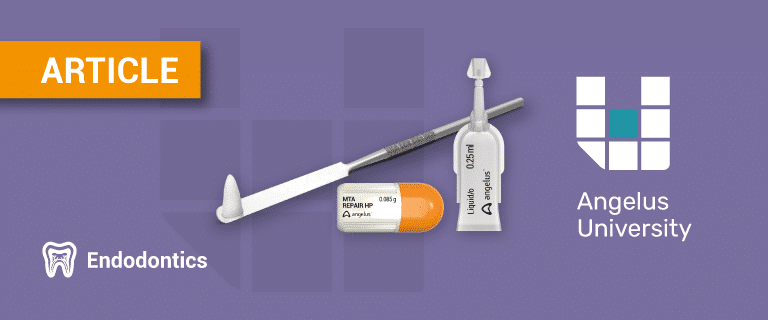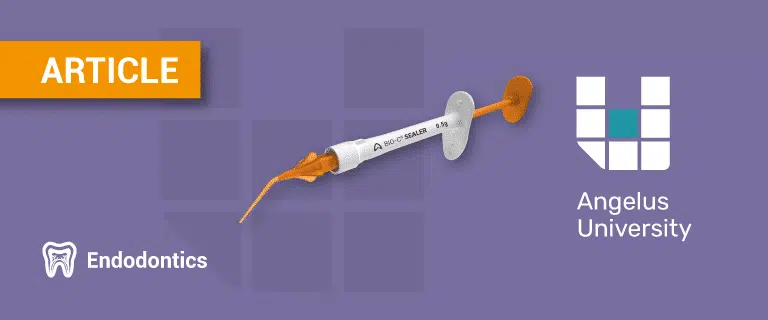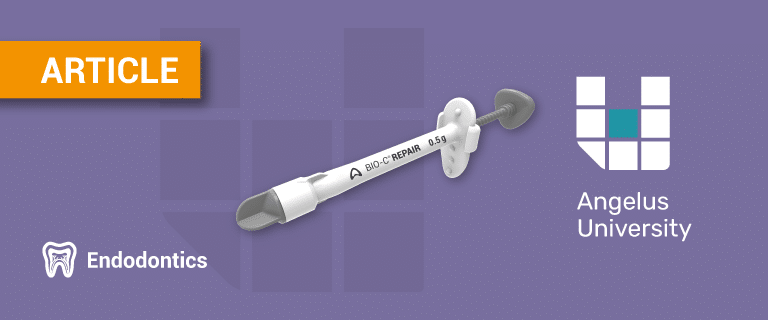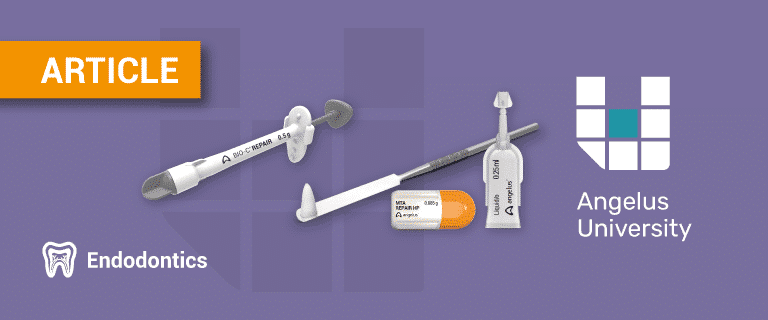
Scientific articles
Check out the main scientific publications that mention Angelus products.

Management of a large, invasive, external, cervical root resorption of a maxillary canine: a case report with a 2-year follow-up
ABSTRACT:
A 2-year clinical and radiologic follow-up showed complete absence of the signs and symptoms associated with the resorption pathology and repair of the lesion. RESORPTION.
REFERENCE:
PANDYA, P.D.; ET AL . Management of a large, invasive, external, cervical root resorption of a maxillary canine: a case report with a 2-year follow-up. https://endopracticeus.com/management-of-a-large-invasive-external-cervical-root-resorption-of-a-maxillary-canine-a-case-report-with-a-2-year-follow-up/octubre_2021

Calcium Silicate Cements vs. Epoxy Resin Based Cements: Narrative Review
ABSTRACT:
The calcium silicate cements analyzed in these studies showed good biological and mechanical properties compared to conventional resin-based cements, resulting in better biocompatibility and less cytotoxicity; long-term studies are needed, but these cements have ideal characteristics to allow ecient filling of root canals.
REFERENCE:
DIOGUARDI, M.; ET AL. Calcium Silicate Cements vs. Epoxy Resin Based Cements: Narrative Review. Oral 2021, 1, 23–35; doi:10.3390/oral1010004.

Calcium silicate‑based cements cause environmental stiffness and show diverse potential to induce osteogenesis in human osteoblastic cells
ABSTRACT:
Cements that quickly stimulate osteoblast differentiation may be ideal for reparative and regenerative purposes since they promptly lead to
dentin or bone deposition.
REFERENCE:
SANTIAGO, M.C.; ET AL. Calcium silicate‑based cements cause environmental stiffness and show diverse potential to induce osteogenesis in human osteoblastic cells. Scientific Reports | (2021) 11:16784 | https://doi.org/10.1038/s41598-021-96353-0.

Dentinal Tubule Penetration and Adaptation of Bio-C Sealer and AH-Plus: A Comparative SEM Evaluation
ABSTRACT:
Under the parameters of this study, BIO C exhibits higher penetration and better adaptation to the dentinal tubules compared to AHP.
REFERENCE:
CACERES, C.; ET AL Dentinal Tubule Penetration and Adaptation of Bio-C Sealer and AH-Plus: A Comparative SEM Evaluation. EUR Endod J 2021. Published online: 22 April 2021 DOI 10.14744/eej.2020.96658

Comparison of Post obturation Pain Experience after Apical Extrusion of Calcium Silicate–and Resin–Based Root Canal Sealers
ABSTRACT:
Different sealers present divergent extrusion rates1,5 and cause variable experiences of postobturation pain when extruded10. Furthermore, extrusion of root canal sealers can even be associated with further complications such as nerve injury.11.
REFERENCE:
DRUMOND, J.P.S.C.; ET AL Comparison of Postobturation Pain Experience after Apical Extrusion of Calcium Silicate–and Resin–Based Root Canal Sealers. JOE Volume -, Number -, - 2021

Impact of Warm Vertical Compaction on the Sealing Ability of Calcium Silicate-Based Sealers: A Confocal Microscopic Evaluation
ABSTRACT:
No differences were observed comparing the HiFlow with the Bio-C sealer. Although the BC sealers are recommended with the SC technique, it might be interesting to reconsider the application of Schilder’s principles with these newly introduced sealers. WARM TECHNIQUE.
REFERENCE:
EID, C.; ET AL. Impact of Warm Vertical Compaction on the Sealing Ability of Calcium Silicate-Based Sealers: A Confocal Microscopic Evaluation. Materials 2021, 14, 372. https://doi.org/10.3390/ma14020372.

Effect of obturation technique using a new bioceramic sealer on the presence of voids in flattened root canals
ABSTRACT:
The percentage of voids in the filled root canals was evaluated, and the data were statistically analyzed using the unpaired t-test (α = 0.05). The root canals filled using the thermoplastic technique created a smaller percentage of voids in the cervical/middle thirds than those filled using the single-cone technique (p 0.05). The flattened root canals in the cervical/middle thirds were better filled using the ready-to-use calcium silicate-based sealer associated to the thermoplastic technique, compared with the single-cone technique. In the apical third, the techniques showed similar filling ability.
REFERENCE:
SANTOS-JUNIOR, A.O.; EL AL. Effect of obturation technique using a new bioceramic sealer on the presence of voids in flattened root canals. Braz. Oral Res. 2021;35:e028.

Cimentos biocerâmicos reparadores fabricados e/ou disponíveis no Brasil: uma revisão de literatura e análise bibliométrica sobre suas propriedades biológicas
ABSTRACT:
Os dados dos artigos avaliados no presente estudo evidenciaram resultados promissores em relação às propriedades biológicas de alguns dos cimentos avaliados (MTA HP Repair® e Bio-C Repair®). Entretanto, para um desses cimentos (PBS HD® Cimmo) sugere-se a realização de estudos adicionais voltadas para a investigação de suas propriedades biológicas. BIOLOGICAL PROPERTIES.
REFERENCE:
FIGUEIREDO JUNIOR, E.C.; ET AL. Cimentos biocerâmicos reparadores fabricados e/ou disponíveis no Brasil: uma revisão de literatura e análise bibliométrica sobre suas propriedades biológicas. Arch Health Invest 10(2) 2021.

Bio-C Repair – A New Bioceramic Material for Root Perforation Management: Two Case Reports
ABSTRACT:
The Bio-C Repair is suggested as a new cement option for the management of lateral canal perforations, with effective results as observed after a one-year follow-up.
REFERENCE:
TOUBES, K.S.; ET AL. Bio-C Repair - A New Bioceramic Material for Root Perforation Management: Two Case Reports. Brazilian Dental Journal (2021) 32(1): 104-110.

SAC
Specialized Customer Service
Monday to Friday, from 7:30 a.m to 5:30 p.m (GMT-3).